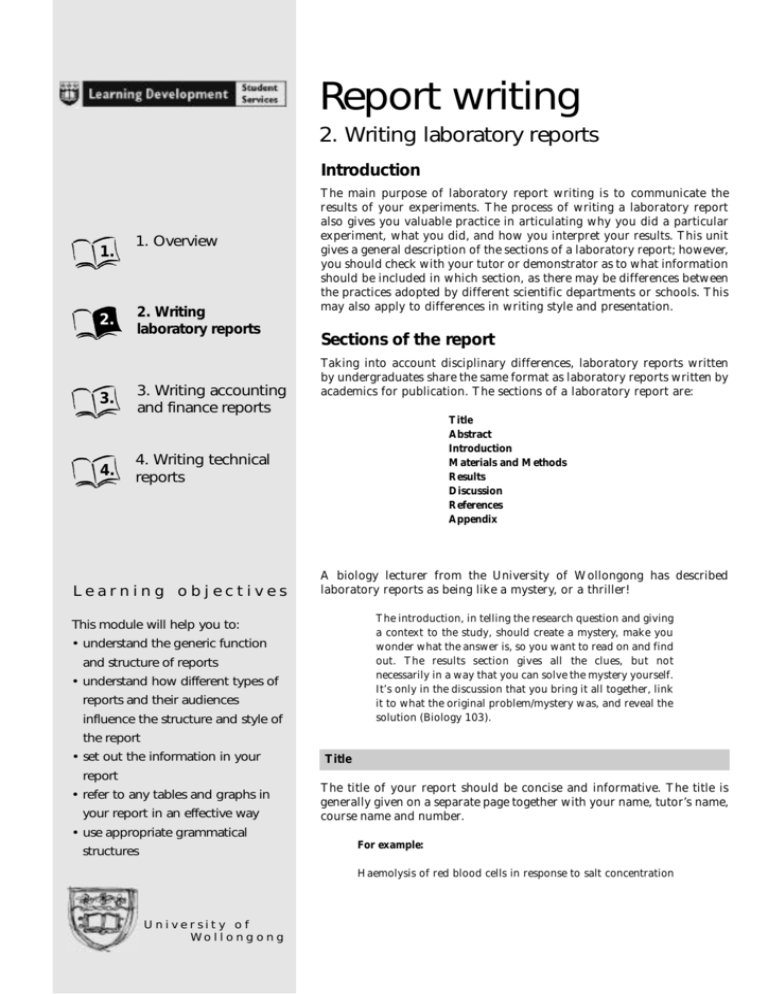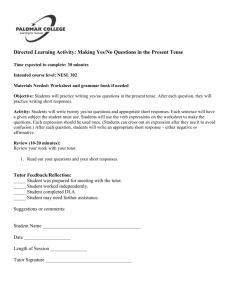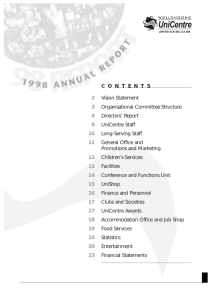Writing laboratory reports
advertisement

Report writing 2. Writing laboratory reports Introduction 1. 2. 3. 4. 1. Overview 2. Writing laboratory reports 3. Writing accounting and finance reports The main purpose of laboratory report writing is to communicate the results of your experiments. The process of writing a laboratory report also gives you valuable practice in articulating why you did a particular experiment, what you did, and how you interpret your results. This unit gives a general description of the sections of a laboratory report; however, you should check with your tutor or demonstrator as to what information should be included in which section, as there may be differences between the practices adopted by different scientific departments or schools. This may also apply to differences in writing style and presentation. Sections of the report Taking into account disciplinary differences, laboratory reports written by undergraduates share the same format as laboratory reports written by academics for publication. The sections of a laboratory report are: Title Abstract Introduction Materials and Methods Results Discussion References Appendix 4. Writing technical reports Learning objectives A biology lecturer from the University of Wollongong has described laboratory reports as being like a mystery, or a thriller! The introduction, in telling the research question and giving a context to the study, should create a mystery, make you wonder what the answer is, so you want to read on and find out. The results section gives all the clues, but not necessarily in a way that you can solve the mystery yourself. It’s only in the discussion that you bring it all together, link it to what the original problem/mystery was, and reveal the solution (Biology 103). This module will help you to: • understand the generic function and structure of reports • understand how different types of reports and their audiences influence the structure and style of the report • set out the information in your Title report • refer to any tables and graphs in your report in an effective way The title of your report should be concise and informative. The title is generally given on a separate page together with your name, tutor’s name, course name and number. • use appropriate grammatical For example: structures Haemolysis of red blood cells in response to salt concentration University of Wollongong Abstract The abstract is a precise summary of the whole report. It includes a statement of the aim or objective of the experiment, a short description of the method used, the main results, and the conclusions or implications of the results. There is generally one sentence per section of the report. The abstract should be between 100 and 150 words. For example: In this experiment, chromatography was used to analyse amino acids in solution. Standards were used to identify unknown amino acids in a mixture. Ascending layer chromatography with an isopropanol-based solvent was used to separate the amino acids, which were then detected with ninhydrin. The unknown mixture analysed was found to contain aspartate and histidine. It was observed that hydrophobic amino acids were most mobile. This technique was shown to be an effective way of analysing unknown mixtures of amino acids. A mechanism for ninhydrin binding to amino acids is proposed, based on observations from this experiment. description aim/ objective method results conclusion further conclusion Introduction This should include: (a) background to the experiment, (b) the objectives of the experiment, and its significance (why it was done). (c) a context for your study. That is, a link with what has already been done. Some departments or tutors may require you to include the aims or objectives of your study in a separate section after the Introduction. It is best to check with your tutor. For example: Introduction Toads and rats are both vertebrates of similar size. Their physiology, however, is quite different, as toads are ectothermic and rats are endothermic (Campbell et al., 1997, pg 487). This means that the body temperature of a toad is responsive to its environment, and it must therefore regulate its body temperature through its behaviour. A rat, on the other hand, has a high metabolic rate, and maintains its body temperature at 37°C, regardless of the external temperature. In this study, the anatomy of the toad and rat were investigated. As well as identifying the various body systems and their component organs, the study was designed to compare the toad and the rat. This comparison should lead to a better understanding of the effect of the different physiologies (ectothermy and endothermy) on internal and external anatomy, and what anatomical adaptations are associated with ectothermic and endothermic lifestyles. background to the experiment (including references to other studies) link between background and significance of the experiment objectives, and significance of the experiment 2 Self directed learning resource, Learning Resource Centre © Learning Development — University of Wollongong 2000 Materials and Methods The purpose of this section is to describe how you proceeded with your experiment with enough detail so someone else could repeat the same procedure. This section should be written in paragraph form with as little repetition as possible. If you are following a procedure described in a manual, you will need to change a list of bulleted points to paragraph format. Also, you will need to change the tense from the present tense (what you do), to the past tense (what you did). Finally, it is important to add any extra information or observations, such as changes, or if the experiment did not go according to plan. For example (excerpt): Growth rates were determined by estimating the number of bacteria in a culture at zero time and after 1 hour of growth at 37°C. In order to make this estimation, a dilution series was performed by diluting aliquots of the bacterial culture, at each incubation time, by a factor of 10, 100, and 10 000 with nutrient broth, and then plating out 0.01ml of each of these dilutions onto quadrants of a sterile agar plate. Following one week’s incubation at 25°C, the colonies of the plate were counted manually. Serial Dilution (see manual, page 1.5) in this excerpt no amounts or descriptions of equipment have been included, as a person wishing to repeat the experiment could change these and still get the same effect. Results This section describes but does not explain your results. (Remember you are giving the clues, not solving the mystery.) You can, however, draw attention to specific trends or data that you think are important. Since you are presenting your results, not the figures which represent the results, you should ensure you refer explicitly to your results and not just to your data figures (graphs, tables). As you describe particular results in the text of your results section, make sure you refer to the corresponding figure in brackets after you have mentioned the results. The figures should be inserted into the text as soon as possible after you mention them. For example (excerpt) Results When samples of hydrolysed and unhydrolysed BSA were analysed by ascending paper chromatography, the appearance and separation of the two samples were quite different. The unhydrolysed BSA had very little colour and appeared to remain on the origin (Fig. 1, lane 7). In its hydrolysed form, however, however, the BSA sample separated into a number of spots which were bright pink or purple (Fig. 1, lane 8). description but no explanation (notice that there is no direct reference to figures but to the results themselves) 3 Self directed learning resource, Learning Resource Centre © Learning Development — University of Wollongong 2000 Discussion In the discussion section of your report, you should interpret and explain your results. This should be linked with the introduction, telling whether and how the questions raised in that section have been answered. You also need to draw conclusions about your results and consider their significance. For example (excerpt) Discussion The activity of the salivary amylase enzyme in this experiment increased with temperature up to 37°C. This was probably an effect on the reaction itself, as the rate of chemical reactions generally increases as temperature increases because there is more energy in the system at higher temperatures (Stryer, 1995, p. 46). Most enzymes are denatured at temperatures above 50°C (Perkins, 1964). However, in this experiment, the activity of the amylase was highest at 70°C. This may be explained by the variation in temperature that is experienced in the mouth during eating, which may require a high degree of heat-resistance in the amylase enzyme … state the major results again interpret/explain based on what is known (cite references) unexpected result explanation The separate sections of Results, Discussion is one way of organising this information. It is also possible to combine the Results and Discussion, and to include a separate concluding section. It is always advisable to check with your tutor about these issues. References Unless information is a) obvious or well known, for example enzymes are proteins or b) has been established by you in your experiment, you will need to cite the source of your information. References are cited in the text, and a bibliography or reference list is included before any appendices you may include. Check with your department on referencing conventions. Appendix The Appendix contains any raw data which were part of the experiment, but which are not essential to the discussion of the results. You need to clearly label each appendix (plural appendices) so that the reader is aware of what it is he or she is looking it. 4 Self directed learning resource, Learning Resource Centre © Learning Development — University of Wollongong 2000 Grammatical features The language of laboratory reports shares many features of academic English: that is, it can be described as abstract, objective and formal (see the self access module Academic Writing). However, there are several grammatical features of laboratory reports, which are peculiar to report writing. One feature is the choice of tense: when you are describing the aims of your report, as well as discussing your results, you will need to use the present tense. In the methods section, however, you are describing what you did. Furthermore, as the focus is on what was done rather than who did it, the passive voice is utilised as it aims to foreground the action, rather than who did the action. Here is a poor example from a methods section. We did a serial dilution by pipetting 0.9 ml broth intolabelled tubes, then adding 2 drops (0.1ml) of the original culture to tube 1, 2 drops of tube 1 to tube 2, 2 drops of tube 2 to 3 and 2 drops of tube 3 to tube 4. Mix the tubes and spread a loopful (0.01 ml) of each tube onto a different quadrant of a labelled agar plate. The pronoun we could have been avoided by using the passive voice (a serial dilution was carried out) Avoid unnecessary repetition In the present tense, this reads like instructions, not a description of what you did. Acknowledgment This unit is based on material prepared for Biology 103 by Dr Wendy Russell. 5 Self directed learning resource, Learning Resource Centre © Learning Development — University of Wollongong 2000









